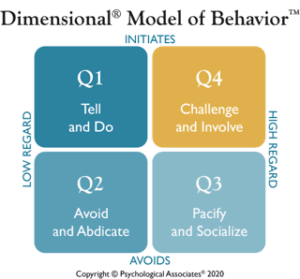The Perils of Communicating Offhanded Information
Dave is a Vice President at a regional insurance firm. He has just hired Michelle to be a claims administrator. She works at a satellite office several hundred miles away. After a three-day orientation with Dave, Michelle has settled into her job. While Dave is her boss, she won’t actually spend much time with him. They converse daily by e-mail, and with occasional phone calls or Zoom sessions if discussion is needed.
After a month, Dave is pleased with Michelle’s work. He recently talked with a long-time commercial client who spoke favorably about working with Michelle. However, the client also mentioned in passing that Michelle was late for several meetings.
Dave is not alarmed by this but feels it’s worth passing along. In an e-mail, he includes this comment: “Marvin also mentioned that you’d been late to the last couple meetings. This client can be kind of cranky that way. So, I would be careful about it with them.”
Surprisingly Defensive Reaction
Because Dave praised Michelle’s work in his e-mail, he is surprised when she calls to talk about the comment. She says she was a few minutes late to one meeting. And for the last meeting, the client didn’t set a specific time. He had said, “Just come by any time after 10:30.” Michelle seems surprisingly defensive over what Dave meant as a heads up, not a criticism.
A Changed Agenda
For Dave, the agenda has changed. Instead of discussing the positives of Michelle’s performance, he’s trying to convince her that the client’s comment did not bother him, and that she’s blowing it out of proportion.
How should Dave have worded his e-mail comment to do a better job of giving helpful, Q4 feedback?

E-mail Communication is Most Suited For…
We hope you don’t mind that we asked a trick question, but we wanted to underscore a point: There is no correct way for Dave to write the e-mail. For this topic, he should have verbally communicated with Michelle instead. I.e. called her, set up a Zoom, or, even better, met with her in person. (Granted, in-person meetings may not always be possible).
Should I Call, IM, or Text?
It’s important as a Q4 collaborative manager to give thought to what communications are appropriate for e-mail and what should be reserved for phone, video conference, or face-to-face conversation.
For the purposes of this article, we’ll consider e-mail and its similar cousin, texting, as the email alternative. Phone calls, face to face meetings, Zoom, Teams or other video conferencing services we’ll consider the verbal alternative. Instant messages (via Teams, Slack, etc.) fall into a similar category as emails and texts.
The rule of thumb is that e-mail communication is most suited for:
- information
- data
- messages where the recipient will not potentially get upset
However, commentary about performance, conduct, opinions, or sensitive issues — i.e., topics that might create an emotional reaction or that could easily be misunderstood — should not be delivered in cold type and sit like a time bomb.
Disadvantages of Email
It’s difficult enough to communicate effectively when we are together and have the benefit of reading body language, facial expressions, and tone of voice. These clues help us interpret not just what people say but what they mean. Even if perfectly worded, e-mails that have emotional undertones or that could hit a nerve are often misunderstood because the other person has to fill in too many blanks. They create more questions than they answer.
Use of emoji and gifs may or may not be appropriate, depending on your company culture or the message you’re conveying, but even that isn’t the cure-all for adding emotional context. Studies have shown multiple people can interpret the same emoji differently.
But Email is Quicker than a Phone Call, Right?
It depends. It is true that for quick exchanges of info or data that is not potentially emotionally charged, e-mail, text, or IM are often quicker than a phone conversation.
However, as in Dave’s case here, if your e-mail generates an unintended emotional reaction, it can cost you way more time trying to undo the damage. If you need to communicate constructive or negative information about someone’s performance, don’t use email. You are much better off investing a few more minutes to do it verbally where you can gauge and immediately respond to their reaction. The 5-10 minutes you save communicating this via e-mail can cost you many times that in time dealing with their anger and misinterpretation. Not to mention the ill will it and negative morale it causes.
Talk in Person
Dave didn’t intend his e-mail as a reprimand or a “big deal.” But Michelle doesn’t have enough history working with him to read between the lines and really gauge his tone. An e-mail doesn’t give Dave the benefit of immediate feedback from Michelle to convey just the right amount of concern.
Complex issues, apologies, and important communications are best handled verbally, not via e-email.
At least Dave isn’t using e-mails in a Q2 aloof manner. Some managers email to avoid dealing directly with people when delivering controversial decisions or opinions.
Before you hit the send button, ask yourself: is e-mail the best option for this communication? Consider honestly if it might be helpful to support what you have to say in person (or by phone if they are not close by). If so, you should deliver the message in that way! People will respect you more for it, and it shows Q4 responsive leadership.
Additional Leadership Resources for You
So if you are walking down the street and someone asks, “when is it OK for me to just send an e-mail?” Congratulations. You now know the answer!
If you found this article helpful, we have over 40 more leadership tips available for you, plus white papers, case studies, and more. Visit our Leadership Learning page.
Are you ready to put your leadership skills into action and become a more effective leader in your workplace? If so, you’ll want to check out our leadership workshops, coaching, and more.
Finally, we don’t want you to miss our future leadership tips and events that can help you be a more effective leader! Subscribe to our newsletter.
Good luck with your continued leadership development!













